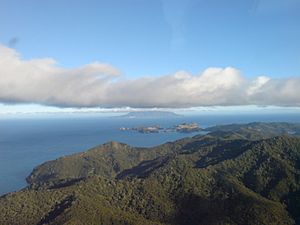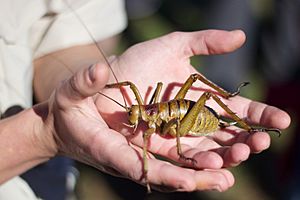Deinacrida heteracantha facts for kids
Quick facts for kids Deinacrida heteracantha |
|
|---|---|
 |
|
| Conservation status | |
| Scientific classification | |
| Genus: |
Deinacrida
|
| Species: |
heteracantha
|
The Deinacrida heteracantha, also known as the Little Barrier giant wētā or wētāpunga, is a very large insect. It belongs to a group of insects called wētā and is found only in New Zealand. For a long time, it lived only on Little Barrier Island. However, some have now been moved to other islands where there are no predators. This giant wētā is mostly active at night, looking for food. But you can also find it during the day, hiding in trees and plants. Experts have listed it as a vulnerable species because its numbers are going down and it lives in only a few places.
Contents
What is a Wētāpunga?
A wētāpunga can weigh up to 70 grams, which is like a small apple! On average, they weigh between 9 and 35 grams. Their body can be about 75 millimeters (3 inches) long. Female wētāpunga are much bigger than males.
These large wētā have a wide body and a round head. They have short mouthparts and relatively short antennae compared to other crickets. They can give a strong kick with their back legs if they feel threatened. Most wētāpunga do not have wings. They mainly eat plants, especially leaves from the forest.
Where Do Wētāpunga Live?
Wētāpunga live in trees in forests. They are found on Little Barrier Island, which is off the coast of New Zealand. This island is about 3,083 hectares in size. Long ago, they lived in forests all over northern New Zealand, including areas like Northland and Auckland.
On Little Barrier Island, they live in different types of forests. You can find them in younger forests on the lower parts of the island. They also live in taller kauri forests higher up. The younger forests have plants like silverfern, nikau palm, mahoe, and kohekohe.
How Do Wētāpunga Behave?
As adults, these giant wētā move around a lot. This means they don't stay in one place for long; they often move to new spots. They live alone and do most of their activities, like eating and moving, at night.
During the day, you can find them hiding under loose tree bark or inside holes in mahoe and pohutukawa trees. Males tend to travel farther than females, both day and night. At night, a male might follow a female, staying about 25 centimeters behind her.
Life Cycle and Babies
The life cycle of the wētāpunga does not follow the seasons. They can live for up to two years. Females lay their eggs during the summer months, from October to December. These eggs usually hatch in March and April of the next year.
Wētāpunga mate almost every month, except during the winter from June to August. Females lay their eggs at night in moist soil. They lay each egg by itself or in small groups of up to five eggs. These eggs are placed in an area about 15 square centimeters and about 2 to 3 centimeters deep. Females lay eggs throughout their lives, but only some of them are fertilized. The eggs take about 125 days to hatch, and only about 36% of them survive.
After hatching, young wētāpunga go through ten growth stages called instars before they become adults. In females, the egg-laying tube (called an ovipositor) can be seen after the third instar. By the sixth instar, it's easy to tell males and females apart. Each instar stage lasts about five to six weeks. Wētāpunga have one more instar than other wētā species. This extra stage makes their young period longer and helps them grow to a larger size.
Wētāpunga do not have special courtship dances or sounds to attract mates. They recognize each other by touch.
How Wētāpunga Make Sounds
Wētāpunga can make sounds by rubbing parts of their body together. This is called stridulation. Many insects, especially crickets, use this method to create sounds. The sounds they make are often linked to certain behaviors.
For wētāpunga, these sounds are mainly used for defense. If they feel threatened, they rub their back legs against their body to make a noise. This noise is a wide-band sound, meaning it covers many frequencies. They produce a main loud sound around 20 kHz and a smaller one around 40–50 kHz. The way their body parts are shaped helps them make these specific sounds.
Dangers to Wētāpunga

In the 1950s, wētāpunga were common on Little Barrier Island. But their numbers have dropped a lot since then. The main reason for this decline is not habitat loss, but predators. Feral cats used to live on the island until they were completely removed in the 1980s. These cats might have eaten young wētāpunga.
Polynesian rats, also called "kiore" in the Māori language, are a big threat to wētāpunga. They mostly hunt and kill young wētā at night. After the feral cats were removed, the number of Polynesian rats increased. Also, birds like saddlebacks hunt wētā during the day. This means wētāpunga are always in danger from predators. There is strong evidence that these rats harm the wētā population, which is common with invasive rodents.
Luckily, the kiore were removed from Little Barrier Island in 2004. This was a great success! The wētāpunga population grew each year, and six years after the rats were gone, their numbers had quadrupled (increased four times). Other animals that prey on wētāpunga include tuatara, geckos, and the North Island brown kiwi at night. During the day, kingfishers and the long-tailed cuckoo also hunt them.
Helping Wētāpunga Survive
The wētāpunga is currently listed as a vulnerable species. Since 2008, the Department of Conservation has been working on a special program. This program involves breeding wētāpunga in zoos and then releasing them into the wild. This helps reduce the risk of all wētāpunga living on just one island.
Wētāpunga caught on Little Barrier Island have been successfully bred at Butterfly Creek and Auckland Zoo. Their offspring have then been released onto Motuora and Tiritiri Matangi Islands. Also, some adult wētāpunga from Little Barrier Island have been moved directly to Motuora. The hope is that these released wētāpunga will create new, healthy populations on these islands, which are free of predators. In 2016, a female wētāpunga was seen on Tiritiri Matangi Island in the area where the first group was released. She must be a descendant of the first 25 wētāpunga moved there in 2011. Wētāpunga moved to Tiritiri Matangi Island in 2014 have also been seen mating.




